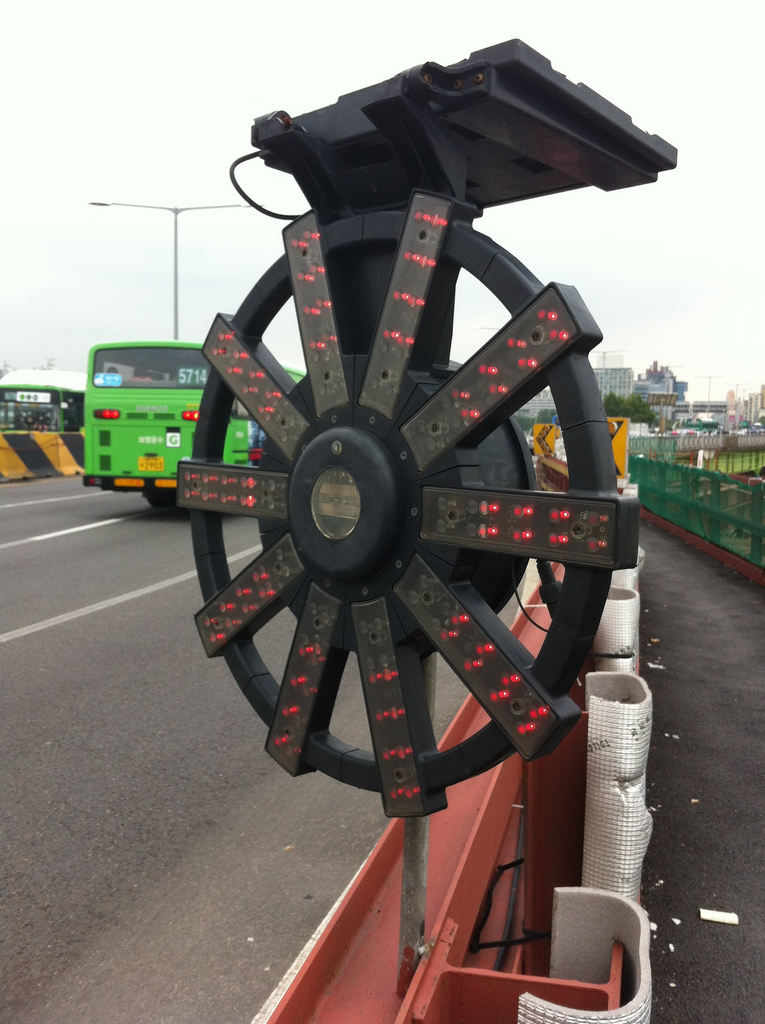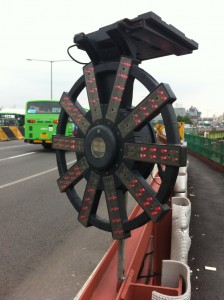Automatons and Uncanny Valleys
This post was inspired by a bike trip through Seoul yesterday, not intentionally as part of the UDrift course, but it certainly seems to feed into the psychogeography post I wrote earlier for that course. The first bit is when I stumbled across a construction site along the dedicated bike trail in Seoul and came to this very human looking automaton (I say automaton instead of robot as robot implies, at least to me, that it does something other than just wave its arm up and down), complete with high quality clothing and spotless work boots. I rode past it, turned around and rode past it again, and then stopped and took this video. I don’t know why, but it split me a bit.
Pragmatically I thought what a good idea. It lowers cost, alerts people to danger, and it is not liable to sue for on-site safety concerns. The second part of me, the emotional part, felt suddenly and completely foreign. I need to think about that a bit before pushing forth an explanation as to why, but it most likely fell somewhere into the uncanny valley school of robotic revulsion.
Hyperawareness to the Foreignness of Signs: Some Design Considerations
So this construction warning, essentially a robotic sign, made me hyperaware to all the signs around me on this bike ride. Some inviting, some alarming (as they are designed to be), and some perplexing. Even though I can read what they say, even though they make sense on a logical level, they made me feel disjointed, out of synch with my environment. Even if that lasted only for the duration of the trip. I realized that these signs are culturally specific, socially pregnant with contextual clues that make sense in that environment. Design being a localized approach, they look, feel, and read like language. All they had me doing was stopping, staring, and drifting off somewhere else. The signs were functionally relevant, yet emotionally and culturally irrelevant to me.
And then the oddest thing happened. I suddenly craved home. Even though I am not sure where that is. Even though I am not sure even what that is. I craved a waystation, perhaps, on this endless nomadic journey of mine. I withdrew from Korea (which has been a home for years) and my heart tried to find its way someplace familiar. I was consciously seeking, not meandering like a flaneur. There was suddenly more emotional and mental urgency to the destination.
These emotional reactions are important considerations for design. When you build pathways, alerts, markers, and general navigation into a system, how do you localize without becoming too insular? How do you avoid robotic revulsion or uncanny valleys? When does the design desire to be soft, comfortable, and inviting lead to infantile searches for mythical homes?
My drift through Seoul echoing my confusion
Some of this pathway through Seoul was intentionally non-linear as I was with a friend and we wanted to drift in whatever direction struck our fancy. Some of it was non-linear precisely because I was intentionally (even before the automaton) attempting to detour from my reflexive paths. I generally go much in the same direction when I ride and so I desired to break from that reflex. I wanted to experience something new. I was merely surprised that what I experienced as new was not the destination or even the journey itself, but rather the signs, the navigation of the journey itself. Those markers that attempt to guide one on their way left me unnerved (just a bit) and homesick (a bit more).
One look at the video I recorded of the GPS from Google Latitude, spliced with some photos from and other bike trips I have taken through Seoul, and edited (very crudely) using Camtasia, is a perfect (I think) illustration of my state of mind on this journey. It starts very directional, almost peaceful. It then erupts in all directions. Multidirectional, non-linear explorations of new ground. Treading and retreading the same ground. Constantly thinking, constantly pondering, lost in my body, legs aching, searching. Looking. Processing. Learning?
[youtube=http://www.youtube.com/watch?v=gxoIKAx8Ui8&feature=youtu.be]



[…] He unnerved me. […]
Fascinating & thought-provoking, thanks!
Glad you liked it, Deborah! Good to hear from you again; hope all is well!
Good idea @HowardScott75. @chrissinerantzi, parallel to your excellent post: https://t.co/Xzxd2eNiWq and https://t.co/MAa5mrmG2p.